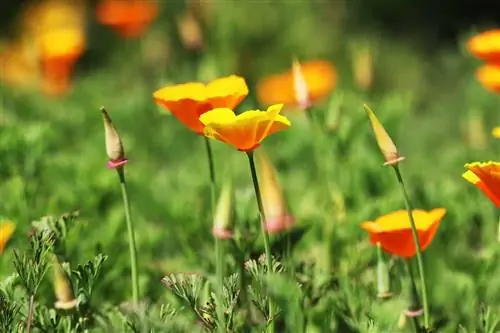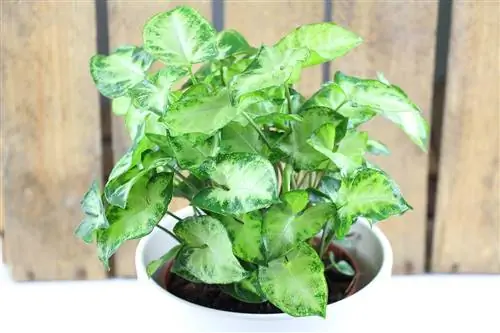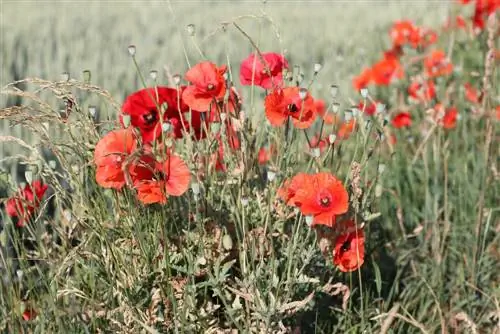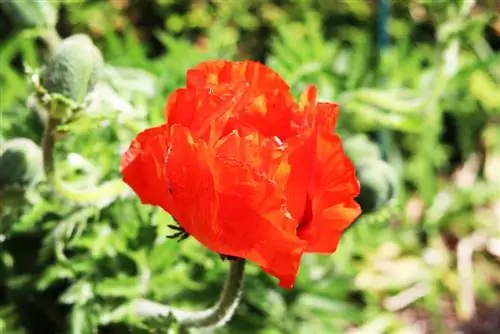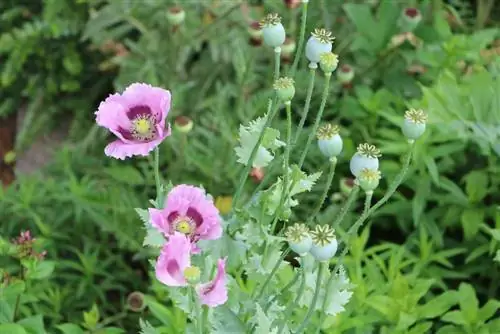- Author admin [email protected].
- Public 2023-12-17 03:39.
- Last modified 2025-01-24 12:45.
Poppies are generally considered to be extremely delicate and sensitive. This may apply to the common corn poppy, but certainly not to its relatives, the Icelandic poppy. Papaver nudicaule is extremely robust and especially prefers cool temperatures. Due to numerous cultivated forms, the color spectrum of this subarctic beauty ranges from yellow to white to bright orange-red. Even cream-colored cup flowers up to 15 centimeters in size are not uncommon. Iceland poppies are the ideal plant for ornamental gardens that are left to their own devices for a short time.
Location and substrate
Not every lushly flowering plant comes from the Mediterranean, as the Icelandic poppy impressively proves. The poppy plant can reach a height of up to 50 centimeters and prefers sunny to semi-shady locations. The original homeland of Papaver nudicaule is in subarctic areas. There it shines in red, yellow to white flower colors. The plant has difficulty coping with heat, which is why you should avoid cultivation near house walls or other stone walls.
Whether it grows as an annual or as a perennial depends on the location and the varieties chosen. However, only minimal demands are placed on the soil. Icelandic poppies can cope just as easily with clayey soils as with sandy or extremely calcareous ones. A slight lack of nutrients in the substrate does not prevent the striking ornamental plant from producing its magnificent flowers. Wild buttercups can thrive even on rubble. You should only avoid soil compaction by using fine gravel. This measure also benefits the other plants in your garden, because water and nutrients can reach the soil more easily.
Watering and fertilizing
The Icelandic poppy copes better with cool, dry conditions than with warmth and permanently moist soil. Therefore, water only moderately on hot summer days and avoid waterlogging. This also applies to cultivation in a planter. Once the substrate has dried, wait another 1 to 2 days before watering the plant. The arctic beauty doesn't really matter whether you use rainwater or calcareous tap water. The root system of this poppy species can easily cope with calcareous soil and water.
Papaver nudicaule is extremely frugal and thrives on poor soil. To promote the flowering potential of the herbaceous plants, it is sufficient to apply compost in the spring. Avoid using special liquid or slow-release fertilizers, as these products can quickly lead to oversaturation of the soil. In such a case, the roots of the weakly consuming plants literally burn. If the Icelandic poppy is cultivated in larger containers, the soil should be prepared annually with small amounts of humus.
Sowing
Preparing the bed and sowing the seeds as desired does not always lead to success with the subarctic plant. While Mediterranean and many domestic plants require warm temperatures or high humidity to germinate, the opposite is true for Icelandic poppies. Because these poppies require rather cool, dry temperatures. Sowing takes place between March and May, but can also be done in September for the following year. Plant the seeds directly on site. The plant is not only suitable as a gap filler in ornamental beds, but also looks decorative in stone and hill beds. Prepare the site as follows:
- Visually mark the area in the bed.
- Mix the substrate with small amounts of humus.
- Spread the fine seeds carefully.
- Press lightly into the soil.
- Pour and keep moderately moist.
Poppy is one of the “light-germinating” plant species. Therefore, only cover the seeds lightly with soil. Just enough so that the seeds are not carried away by the wind or immediately discovered by hungry birds. Cultivation in containers is not always successful. Young Icelandic poppies are sensitive to changes, including moving to a new location. If you still want to move the plants, you should do this in spring or autumn.
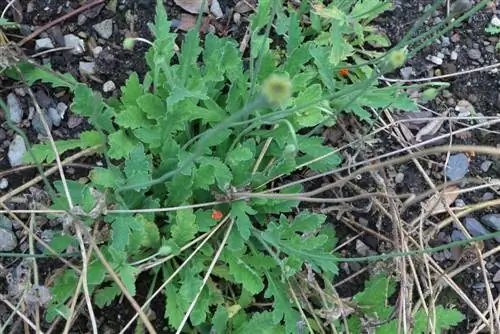
Icelandic poppies can be grown all year round in larger pots on the balcony or sunny terrace. You should be careful when choosing a planter. The poppy seeds only come into their own in particularly large pots. You are also free to combine the flowering plants with other ornamental plants. Many seemingly cheap vessels become brittle during the intense sunlight in summer. You should therefore prefer products made of clay or stoneware.
Tip:
Iceland poppies can develop their splendor particularly well with asters or lilies. Always plant several different types of plants so that there are no unsightly gaps after flowering.
Propagate
Like all poppy species, Papaver nudicaule also forms the characteristic seed capsule. This opens immediately after ripening and the seeds, which are only millimeters in size, are distributed over a large area by the wind. To avoid self-seeding, you can also remove the fruit capsule when it is half ripe. The best way to do this is to hold a small mason jar underneath the plant and drop the seed capsule directly into it. This will prevent the fine seeds from falling to the ground.
Wild species of Iceland poppy are usually perennial, while various cultivated forms have to be sown fresh every year. The original species can also be propagated using side shoots. These can be cut on frost-free days in late autumn or winter.
- Expose the roots.
- Cut off several side shoots about 10 centimeters long.
- Place the shoots in a container with poor soil.
- The location should be cool and bright.
- Keep moderately moist until spring.
- Avoid proximity to active radiators.
If new leaves and shoots appear in spring, root formation is complete. Immediately move the young poppy plants to their final location outdoors. Iceland poppy is not suitable for long-term cultivation indoors.
Cutting
The ornamental plants are not trimmed or pruned. Icelandic poppy has a special feature: In contrast to other poppy plants, Papaver nudicaule is a long-lasting cut flower. Even the dried seed capsules are often used by many florists in dried flower bouquets due to their decorative appearance. However, bringing the colorful splendor of the blooming Icelandic poppy into your own four walls requires some effort. Cut flowers when the buds are still half-closed. The cut parts of the plant must also be treated so that the poisonous milky sap does not escape and rob the flower of all its remaining vitality.
- Cut the poppy to the desired length.
- Singe the stem end with a lighter or hot water.
- Place in a container with lukewarm water.
- The location should not be too sunny.
Even if purchased Iceland poppy cut flowers are too long for the vase, you can shorten them and reseal them in this way. However, the lifespan of the cut ornamental flowers cannot be extended by regularly shortening the poppies.
Wintering
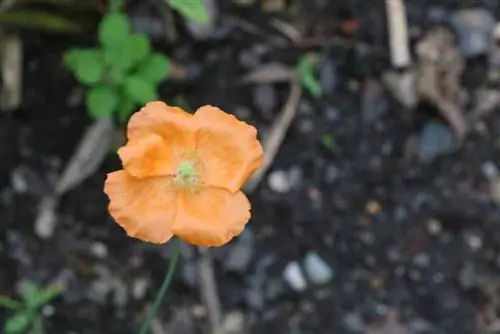
Cold-loving plants are extremely robust and, even with special precautions, can get through the cold season unscathed. While Iceland poppy species cultivated as annuals die off in late autumn, the fleshy root network of the perennial plants rests protected in the ground. Wild Papaver nudicaule varieties cultivated in pots still gratefully accept a warming layer of fleece or burlap. Wrap the planter to prevent the substrate from freezing completely.
Profile
- Species/Family: Perennial. Belongs to the poppy family (Papaveraceae)
- Flowering time: Forms typically poppy-shaped, smaller cup flowers in yellow, orange, white and red throughout the summer from June to September. Each plant produces flowers in all different colors
- Foliage: Blue-green, elongated leaves with fine hairs, curved at the edge. Some varieties occasionally survive the winter and show green leaves even when there is frost
- Growth: Bushy growth with low tufts of leaves from which the hairy flower stalks protrude tightly upright
- Height: 20 to 60cm
- Location: Sunny. Permeable, rather poor soil
- Planting time: Can be grown from seeds directly outdoors in July-August (germination time 10-20 days at 18-22 degrees Celsius)
- Pruning: No pruning required
- Partner: Blue forget-me-nots. Beautiful in tuffs from several plants
- Propagation: Likes to sow itself or seeds can be collected (see propagation below)
- Care: Water only if it is dry for a long time. Fertilizing not necessary
- Overwintering: Can hardly be brought over the winter even under the best conditions, therefore counts as an annual
- Diseases/Problems/Pests: Very popular with snails
- Special features: Although it is considered a perennial, it is difficult to survive over the winter, so it is usually an annual
Varieties (selection)
- `Garden gnome: height 30cm. Mixture that blooms from June to September. Due to the height it is also good for the rock garden or as a bed border
- `Illumination: height 40cm. Forms mainly flowers in pastel tones
- `Wonderland: height 20-25cm. Colorful flowers. Canceled mainly due to wintergreen foliage
Conclusion
The colorful Icelandic poppy is easy to cultivate and - unlike many other ornamental plants - thrives preferentially in poor soils. There is very little to consider when sowing and caring for it. Papaver nudicaule proves quite impressively that not all poppy species are unsuitable as cut plants.


